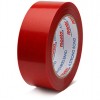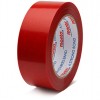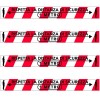The difference of microns between polypropylene, high strength, and PVC tapes
What difference of microns do “normal” polypropylene tapes, high strength and PVC tapes have between each other? When consider purchasing adhesive tape, in particular adhesive tape meant to seal cardboard boxes, you may not immediately think about the thickness.
The attention goes to other aspects instead, such as the length of the roll – to more or less understand how many boxes can be closed with a single roll – or how the width of strong double-sided adhesive tape, as well as its colour, possible customizations by means of printing, the noise level when unwrapping it, its duration once applied, storage conditions, and so on.
But when purchasing professional adhesive tape meant for packaging operations – as well as in the case of industrial double-sided adhesive tape – you’ll soon come across the measurement of the thickness of industrial double-sided adhesive, which is expressed in microns.
You might then ask yourself about the thickness of various adhesive tape rolls according to their material, as well as what the real consequences of these differences are. Let’s have a look at how the thickness of the tape changes by microns, and what this deviation entails, together.
A matter of microns
The micron is certainly not a unit of measurement that we often use in our daily lives. The micrometre corresponds to one millionth of a meter, or one thousandth of a millimetre.
It should be noted that, although the micrometre is often indicated by the abbreviation my, in reality the exact symbol would be µ, and even more correctly µm.
It is not surprising that the micrometre is used only in specific sectors, because it is so tiny that it is used to express the thickness of paint layers, or the thickness of particular films, or indeed adhesive tape, such as in our case.
And again, the micrometre is often used in electronics, in the field of integrated circuits, in which a micron can, in fact, make a noticeable difference.
To understand the order of magnitude we are talking about, you should keep in mind that a red blood cell has a diameter of 8 micrometres, that our hair can have a diameter between 65 and 78 microns, and that the aluminium sheets we use in the kitchen have a thickness of 12 microns.
Let’s now outline what micron difference “normal” polypropylene tapes, high strength, and PVC ones have between one another.
What micron difference do “normal” polypropylene tapes, high strength and PVC tapes have between each other?
As it is known to those who buy professional adhesive tape meant to seal packages with a certain frequency, and especially to those who buy large quantities of this tape, these products are divided essentially into three groups. Propylene tape, PVC tape, and paper tape.
Not to mention, high resistance tape, which can be made with each of the three different supports listed above, as they are, indeed, supports, i.e., the material of the tape which gives a “body” to the double-sided tape itself above the lower layers meant for the actual adhesive action.
In general, normal polypropylene (PPL) adhesive tape used to seal boxes has a support thickness between 25 microns and 28 microns. Therefore, this is an extremely thin adhesive tape.
Double-sided PVC tapes, on the other hand, is naturally thicker, thought the difference is impossible to catch with the naked eye: usually this kind of adhesive tape start from a minimum thickness of 32 microns.
High-strength tapes, designed for the sealing of particularly heavy boxes, which need more power and resistance, can be found to be slightly thicker. But does this really make a difference?
The thickness of PPL tape meant for the sealing of heavy boxes
Those needing to seal large and heavy boxes, which may need to be stored for a long time and moved in different ways, have a vested interest in choosing high-performance adhesive tape to seal their boxes.
For instance, PPL tape (which, as we have outlined, usually have a thickness between 25 and 28 microns) can in these cases have greater thickness, even reaching 33 or 35 microns.
But keep this in mind: in reality, the greater strength and power of this high-performance tape isn’t due to its increased thickness, but rather to the adhesives used to produce industrial double-sided adhesive tape. The difference in grip between a 28-micron polypropylene tape and a 35-micron tape, leaving aside the question of adhesiveness, is, in fact, minimal.







